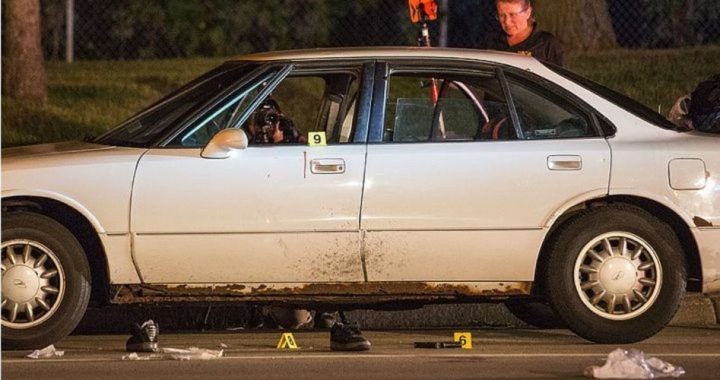
The Black Lives Matter crowd has used the police shootings of two black men to accuse all white people, all police officers, and especially all white police officers of systematic racism and targeting black men for murder. In a previous article, The New American reported on what is known about Alton Sterling’s death and the events leading up to it. But what about Philando Castile, who was shot and killed by a police officer in Falcon Heights, Minnesota, while — according to his girlfriend — he was just reaching for his wallet?
There are some similarities — and some differences — in these two shootings and in the lives of the black men who were shot. While the Black Lives Matter (BLM) crowd has focused on only the similarities that serve its purpose (both men were black, while none of the officers involved was black), they have avoided the similarities that are both most obvious and most important:
• Both men were suspects in crimes involving the threat of lethal force.
• Both men were armed.
• Both men refused to comply with officers’ commands.
In the previous article mentioned above, this writer detailed each of these points in the shooting of Alton Sterling. What has not been widely reported — and has, in fact, been largely ignored by the mainstream media — is that all of the above points apply equally to Philando Castile.
In opposition to the statement given by Diamond “Lavish” Reynolds the morning after the shooting, the real reason officers stopped Castile’s car was not that he had a faulty tail light. It was that he fit the description of a suspect in an armed robbery days before at a convenience store not far from where he was pulled over. It is possible that the officers used the pretext of the tail light so that Castile would not be aware of the real reason for the stop until backup could arrive. It is also possible that Reynolds fabricated the tail light story.
Reynolds’ statement is rife with inconsistencies and untruths, and while this writer is hesitant to accuse her of lying, the facts speak for themselves. Here are just a few examples of the discrepancies in her statement:
• She claimed that she started the recording immediately after the shooting and that her four-year-old daughter was in the back seat. In opposition to those claims, the video — which is a single live stream and is at no point interrupted — shows that at no point during the video do officers remove her daughter from the car. When Reynolds is removed from the car, she asks an officer, “Where’s my daughter? Do you got my daughter?” Her daughter can be seen in the arms of an officer. Also, by this time, several other officers are on the scene. This demonstrates that she did not start the video immediately because, (a) her daughter had already been removed from the car, and (b) backup had already arrived.
• She claimed in her statement that she was kept at the precinct from the time that she was taken into custody immediately after the shooting until 5 a.m., when she claims officers dropped her and her daughter off in front of her house. Police radio communications — captured and recorded by a police scanner — however, provide a record that she was dropped off at her house within three hours of the shooting. This matches police statements that she was “held for about two hours in what’s called a ‘soft interview room’ because it also contains toys, books and blankets.”
• She claimed officers did not call for medical help or administer CPR. Police radio traffic of dispatch calls show that officers called for an ambulance immediately. Police records also show that while waiting for medical help, the officers on the scene began performing CPR within three minutes of the shooting.
Whether the officers told Castile and Reynolds that the stop was because of a broken tail light is not known; it is also not relevant. What is known for certain — from recordings of a police scanner — is that the officers stopped Castile because he matched the description of one of two people who had robbed a convenience store at gunpoint just days before. What is also known — from Reynolds’ video — is that Castile’s gun can be seen on his lap after the shooting. The officer can be heard saying, “F**k! I told him not to reach for it! I told him to get his hand off of it!” If, as Reynolds claims, he was reaching for his wallet, how did the gun wind up on his lap?
Considering that it is now known for certain that officers stopped Castile because he was a suspect in an armed robbery, it seems unlikely that the officers would have asked Castile to reach for his wallet. According to Reynolds’ statement, the officers had already drawn their weapons and told both Castile and Reynolds to raise their hands. Even if the officer did then ask for identification, once the gun was introduced into an already tense situation and the officer ordered Castile not to move, he failed to comply and the officer’s statement — captured on the video — is that Castile reached for and had the gun in his hand when the officer shot him.
As this writer wrote before much of this was known:
In the case of Castile, this writer has some experience. I have, from time to time, carried a firearm. I have been stopped by police while carrying. I have always rolled my window down, placed my hands on the steering wheel, and informed the officer that I was armed. I then sat calmly and asked, “Officer, what would you like me to do?” Sometimes, they have said, “Nothing. I just need to see your license and registration.” Other times they have asked me where the weapon is. Sometimes they have asked me to step out of the vehicle while they secured the weapon. I have always complied. I have done so because I recognize that surprising a police officer with the presence of a gun raises the danger in any situation.
To further illustrate this point, though, Castile was a concealed carry permit holder. This means that the training class he took before receiving that permit would have made him aware of his obligation to comply with the officer’s order not to move. And this was far from the first time Castile had been pulled over. Multiple media outlets have reported that he had been stopped at least 31 times. With both his experience and his training, he knew to obey the officer’s order not to move. Instead, though, Castile continued moving and created a situation where the officer had two choices: Wait to see if an armed robbery suspect was going to use his gun or shoot to stop the threat.
Whether Castile was involved in the robbery or not is not known for certain and is not the point anyway. The point is that — BLM claims to the contrary — this situation had nothing to do with race and everything to do with Castile’s failure to obey the officer’s commands.
It is not the place of media, BLM, social media activists, or social justice warriors to determine whether the officers acted appropriately or inappropriately. That is for the investigation to decide. That investigation needs to be conducted either locally or at the state level. Unfortunately, even before the facts could be known, Minnesota Governor Mark Dayton — playing to the BLM crowd — indicated that the shooting was racially motivated and asked for a federal investigation.
The two things that needed not to happen as a result of this shooting have both already happened: violence against police — particularly the mass shooting in Dallas — and federal involvement and control over local police matters, which are not solutions. They are worse than the supposed problem they claim to solve. Communities have to face their own local problems and work together — across racial lines — to solve them. And they need to support local police and keep them independent of federal control.
Photo of Castile’s car as it is being photographed by investigators




